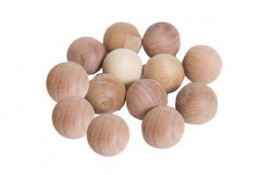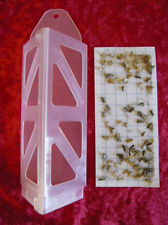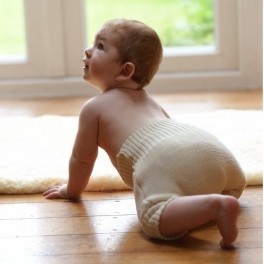When you put your lovely wool and silk things away over Summer, you want to be sure that in the Autumn they're still looking and feeling soft and beautiful.
The main worry when storing wool clothes is... Tineola Bisselliella, the clothes moth. The common clothes moth, or wool moth, is on the increase in Britain and if you've found small holes in your woollen clothes, it's the likely culprit.
Wool moth larvae are hungry for your wool and will also enjoy silk, leather, cashmere, alpaca and any other natural fibre - sometimes even cotton. Their favourite is grubby, sweaty, smelly natural fibres - these are like cake crumbs to an ant, or tasty cheddar to a mouse - irresistable!
So here are our top 5 natural tips for keeping the clothes moth at bay. If you're reasonably organised, we guarantee these will work! But if housekeeping is not your thing, scroll to the end...
Tip 1 - Expose your wool clothes to light
This is so simple, and really works! Unlike most moths, clothes moths don't like light or fresh air. So, shake out those jumpers, beat your carpets outside, hang out your wool blankets in the sun and brush them.

It's a fact that the clothes moth larvae will wriggle away from the sun - and if they can't escape, the larvae will drop off your clothes. Marvellous. And if you brush your clothing too, you brush off or damage the eggs and break the cycle again.
The life cycle of clothes moths is about 3 weeks, so I try and hang out our wool blankets and sheepskins every few weeks on the line. This also refreshes them, and seems to keep them lovely and soft too.
Tip 2 - Hoover them up
Clothes moths are on the increase. One reason that's been given is that, as a nation, our home cleaning habits leave a little to be desired. Hoovering and cleaning just what you can see leaves nooks and crannies for moths to breed in - the corners of the cupboards, around the skirting boards, in the carpet under the chair...
Clothes moths like to be undisturbed to breed. We need to disturb them! So turn out your clothes drawers and cupboards, and hoover inside them, move chairs and chests of drawers and hoover under them. And then throw away the hoover bag!
Tip 3 - Lavender and cedar balls
Bags of lavender and cedar balls are the most natural moth repellents. On the plus side, they are non-toxic and easy to get hold of. Cedar oil will kill young larvae (though not eggs, older larvae or moths) and lavender acts as a repellent. The downside is that the lavender will need replacing - it needs to be fresh to be effective, and the same for the cedar balls too.

You can use lavender oil as well as lavender flowers, and you can replenish the cedar oil from your cedar balls or blocks directly. As cedar oil needs to be in sufficient concentrations to protect your woollens, ideally you need to keep susceptible clothing in sealed chests or tubs to allow the concentrations to build up.
We've found pheromone moth traps work really well too. They're impregnated with the female moth pheromone which entices the male moth, which then gets stuck in the gluey sticky trap. They're pretty good for keeping numbers low, but won't eradicate an infestation.

Tip 4 - Store your woollens clean
I used to wait until I had "enough" wool clothing that needed washing to make up a wool wash. Now I don't, because wool moths love undisturbed, grubby wool. Your wool washing basket is their perfect home.
So, wash your wool, silk, cashmere, alpaca and all your finest fibres fairly soon after they go in the washing basket and the moths will be kept at bay.
If you can, dry in sunlight.
Always store your wool clothes over the Summer just after washing so that they're nice and clean. Dry cleaning is very effective too, though very often not an eco-friendly option.
Tip 5 - Freeze the clothes moth out!
Sealing and freezing is our top tip for long-term storage. Many of our customers recommend vacuum bags: launder your clothes first, bag them with lavender or cedar, and seal the bags for safe long-term storage.
"I wash our woolens and then store them clean in the freezer. They are such treasures, I don't mind sacrificing the space." - Alison
"And if you freeze them in ziplocks, then you can take them out and store them anywhere, bug-free!" - Jennifer
How long should you freeze them for? Most sites say 3 days, some are more cautious and go for two weeks. After this you can free up your freezer space again, knowing you'll have happy healthy woollens come the Autumn. Otherwise four days in the freezer is enough to kill any larvae that are left, guaranteeing you hole-free beauty come the Autumn.
Freezing is a safe, effective natural option to remove clothes moths.
Summary - to protect your wool from clothes moths, remember
- Sun and air
- Hoover and clean
- Store with lavender and cedar
- Use pheromone moth traps
- Seal and freeze!
And if you're not so organised...
I'd still recommend moth traps (they last for months, which even I can manage to cope with) and I'd also recommend not waiting to wash your woollens. A couple of jumpers and a pair of socks is a good wool wash!

But if you're not a natural 1950s home-maker, let's face it, however much you love gorgeous natural fabrics you probably won't replenish the lavender, and vacuum bags just drive you mad. Airing jumpers every three weeks or hanging out wool blankets is just not going to happen - and as for hoovering cupboards... honestly! What an idea.
Moth balls are not a solution - they're often very toxic, generally smelly and their vapours can be carcinogenic. Nice. And chucking a few cedar balls in just isn't going to work.
Luckily there is a solution, though not a natural one. Look into chemical paper strips - these are impregnated with modern chemical moth killers that are nowhere near as unpleasant as old-fashioned ones, and will kill off the larvae too. You can even layer them touching your clothes, though you might prefer to protect your clothing from direct contact with paper.
And though this is not a natural solution, it's still better for you and for the environment to make your good quality clothing last!










